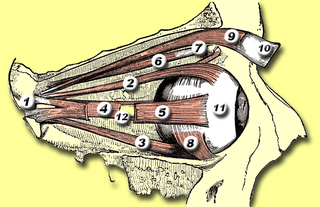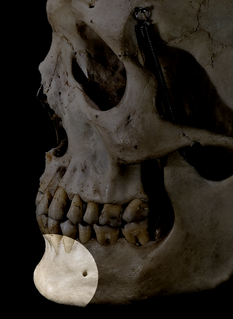Related Research Articles

Plastic surgery is a surgical specialty involving the restoration, reconstruction, or alteration of the human body. It can be divided into two main categories: reconstructive surgery and cosmetic surgery. Reconstructive surgery includes craniofacial surgery, hand surgery, microsurgery, and the treatment of burns. While reconstructive surgery aims to reconstruct a part of the body or improve its functioning, cosmetic surgery aims at improving the appearance of it.

Reduction mammoplasty is the plastic surgery procedure for reducing the size of large breasts. In a breast reduction surgery for re-establishing a functional bust that is proportionate to the woman's body, the critical corrective consideration is the tissue viability of the nipple–areola complex (NAC), to ensure the functional sensitivity and lactational capability of the breasts. The indications for breast reduction surgery are three-fold – physical, aesthetic, and psychological – the restoration of the bust, of the woman's self-image, and of her mental health.

A Pancoast tumor is a tumor of the apex of the lung. It is a type of lung cancer defined primarily by its location situated at the top end of either the right or left lung. It typically spreads to nearby tissues such as the ribs and vertebrae. Most Pancoast tumors are non-small-cell lung cancers.

Horner's syndrome, also known as oculosympathetic paresis, is a combination of symptoms that arises when a group of nerves known as the sympathetic trunk is damaged. The signs and symptoms occur on the same side (ipsilateral) as it is a lesion of the sympathetic trunk. It is characterized by miosis, partial ptosis, apparent anhydrosis, with apparent enophthalmos.

A facelift, technically known as a rhytidectomy, is a type of cosmetic surgery procedure used to give a more youthful facial appearance. There are multiple surgical techniques and exercise routines. Surgery usually involves the removal of excess facial skin, with or without the tightening of underlying tissues, and the redraping of the skin on the patient's face and neck. Exercise routines tone underlying facial muscles without surgery. Surgical facelifts are effectively combined with eyelid surgery (blepharoplasty) and other facial procedures and are typically performed under general anesthesia or deep twilight sleep.
Chin augmentation using surgical implants can alter the underlying structure of the face, providing better balance to the facial features. The specific medical terms mentoplasty and genioplasty are used to refer to the reduction and addition of material to a patient's chin. This can take the form of chin height reduction or chin rounding by osteotomy, or chin augmentation using implants. Improving the facial balance is commonly performed by enhancing the Chin using an implant inserted through the mouth. The goal is to provide a suitable projection of the chin as well as the correct height of the chin which is in balance with the other facial features.

The levator palpebrae superioris is the muscle in the orbit that elevates the upper eyelid.

An inverted nipple is a condition where the nipple, instead of pointing outward, is retracted into the breast. In some cases, the nipple will be temporarily protruded if stimulated. Both women and men can have inverted nipples.
Mastopexy is the plastic surgery mammoplasty procedure for raising sagging breasts upon the chest of the woman, by changing and modifying the size, contour, and elevation of the breasts. In a breast-lift surgery to re-establish an aesthetically proportionate bust for the woman, the critical corrective consideration is the tissue viability of the nipple-areola complex (NAC), to ensure the functional sensitivity of the breasts for lactation and breast-feeding.

The superior tarsal muscle is a smooth muscle adjoining the levator palpebrae superioris muscle that helps to raise the upper eyelid.

The human chin is the forward pointed part of the anterior mandible below the lower lip. A fully developed human skull has a chin of between 0.7 cm and 1.1 cm.

Ptosis or sagging of the female breast is a natural consequence of aging. The rate at which a woman's breasts drop and the degree of ptosis depends on many factors. The key factors influencing breast ptosis over a woman's lifetime are cigarette smoking, her number of pregnancies, higher body mass index, larger bra cup size, and significant weight change. Post-menopausal women or people with collagen deficiencies may experience increased ptosis due to a loss of skin elasticity. Many women and medical professionals mistakenly believe that breastfeeding increases sagging. It is also commonly believed that the breast itself offers insufficient support and that wearing a bra prevents sagging, which has not been found to be true.

Ptosis, also known as blepharoptosis, is a drooping or falling of the upper eyelid. The drooping may be worse after being awake longer when the individual's muscles are tired. This condition is sometimes called "lazy eye", but that term normally refers to the condition amblyopia. If severe enough and left untreated, the drooping eyelid can cause other conditions, such as amblyopia or astigmatism. This is why it is especially important for this disorder to be treated in children at a young age, before it can interfere with vision development.
Blepharochalasis is an inflammation of the eyelid that is characterized by exacerbations and remissions of eyelid edema, which results in a stretching and subsequent atrophy of the eyelid tissue, leading to the formation of redundant folds over the lid margins. It typically affects only the upper eyelids, and may be unilateral as well as bilateral.

Blepharophimosis is a congenital anomaly in which the eyelids are underdeveloped such that they cannot open as far as usual and permanently cover part of the eyes. Both the vertical and horizontal palpebral fissures are shortened; the eyes also appear spaced more widely apart as a result, known as telecanthus.
Chronic progressive external ophthalmoplegia (CPEO) is a type of eye disorder characterized by slowly progressive inability to move the eyes and eyebrows. It is often the only feature of mitochondrial disease, in which case the term CPEO may be given as the diagnosis. In other people suffering from mitochondrial disease, CPEO occurs as part of a syndrome involving more than one part of the body, such as Kearns–Sayre syndrome. Occasionally CPEO may be caused by conditions other than mitochondrial diseases.
Inferior alveolar nerve block is a nerve block technique which induces anesthesia (numbness) in the areas of the mouth and face innervated by one of the inferior alveolar nerves which are paired on the left and right side. These areas are the skin and mucous membranes of the lower lip, the skin of the chin, the lower teeth and the labial gingiva of the anterior teeth, all unilaterally to the midline of the side on which the block is administered. However, depending on technique, the long buccal nerve may not be anesthetized by an IANB and therefore an area of buccal gingiva adjacent to the lower posterior teeth will retain normal sensation unless that nerve is anesthetized separately, via a (long) buccal nerve block. The inferior alveolar nerve is a branch of the mandibular nerve, the third division of the trigeminal nerve. This procedure attempts to anaesthetise the inferior alveolar nerve prior to it entering the mandibular foramen on the medial surface of the mandibular ramus.
Unlike the flexible flat foot that is commonly encountered in young children, congenital vertical talus is characterized by presence of a very rigid foot deformity. The foot deformity in congenital vertical talus consists of various components, namely a prominent calcaneus caused by the ankle equines or planter flexion, a convex and rounded sole of the foot caused by prominence of the head of the talus, and a dorsiflexion and abduction of the forefoot and midfoot on the hindfoot. It gets its name from the foot's resemblance to the bottom of a rocking chair. There are two subcategories of congenital vertical talus namely idiopathic or isolated type and non-idiopathic type which may be seen in association with arthrogryposis multiplex congenital, genetic syndromes and other neuromuscular disorders.
Scarless Serdev Suture suspension liftings use percutaneous skeletal fixation of movable fascias without incisions. In Brazil known as fio elastico., are used to correct early ptosis and flabbiness in areas of face and body. The suture suspension techniques are described to lift, if necessary to form volume and to correct position of soft tissue without traditional incisions.
Eyelid revision is a procedure that involves correcting or addressing any issues that have arisen from a previous eyelid surgery. The surgery is more difficult to perform and is more complicated than an initial eyelid revision surgery, since the site of the procedure has been operated on before. The reasons for eyelid revision surgeries include contour abnormalities, asymmetry and unusually high eyelid height. The procedure is known to have more complications and issues than initial eyelid surgeries due to the presence of excess scar tissue at the surgery site.
References
- ↑ de la Torre, Jorge I.; Martin, Scot A.; Al-Hakeem, Mazin S.; De Cordier, Benoit C.; Vasconez, Luis (2004). "A Minimally Invasive Approach for Correction of Chin Ptosis". Plastic and Reconstructive Surgery. 113 (1): 404–409. doi:10.1097/01.PRS.0000097303.53197.59. PMID 14707666. S2CID 42678676. Archived from the original on 2016-03-03. Retrieved 2009-09-02.